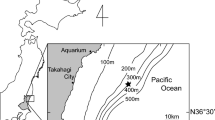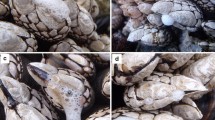Abstract
Sperm displacement behavior of cuttlefish (Sepia esculenta) was observed in a tank. Before ejaculation, male cuttlefish used their arms III to scrape out sperm masses attached to the buccal membranes of females. The removed sperm mass debris was directly visible and countable. Active sperm were present within the removed sperm debris, implying that the aim of this behavior is to remove competing male sperm. However, many sperm masses remained on the female buccal membrane even after the removal behavior, showing that sperm removal in S. esculenta is incomplete. The duration of sperm removal (an indicator of male investment in that process) was unaffected by the body sizes of mated pair, the duration of spermatangia placement at the current mating (for the hypothesis that the sperm removal serves to creat attachment space of spermatophores), or the estimated amount of sperm masses deposited from previous matings. Moreover, male S. esculenta performed sperm removal regardless of whether the last male to mate with the partner was himself, suggesting males remove not only the sperm of rivals but also their own. Although the number of removed sperm masses increased with the time spent on removal of sperm, male cuttlefish may shorten the duration of sperm removal to avoid the risk of mating interruption. We conclude that this time restriction would likely influence the degree of partial sperm removal in S. esculenta. A digital video image relating to the article is available at http://www.momo-p.com/showdetail-e.php?movieid=momo040729se01a.







Similar content being viewed by others
References
Adamo SA, Hanlon RT (1996) Do cuttlefish signal their intention to conspecifics during agonistic encounters? Anim Behav 52:73–81
Arakawa Y (1960) Miscellaneous notes on Mollusca, 2. Mating and spawning habits of some marine mollusca. Venus 21:72–78 (in Japanese with English resume)
Birkhead TR, Møller AP (1998) Sperm competition and sexual selection. Academic Press, London
Boal JG (1996) Absence of social recognition in laboratory-reared cuttlefish, Sepia officinalis L. (Mollusca: Cephalopoda). Anim Behav 52:529–537
Boal JG (1997) Female choice of males in cuttlefish (Mollusca: Cephalopoda). Behaviour 134:975–988
Eberhard WG (1996) Female control: sexual selection by cryptic female choice. Princeton University Press, Princeton, N.J.
Faul F, Erdfelder E (1992) GPOWER: A priori, post-hoc, and compromise power analyses for MS-DOS. Bonn University, Bonn
Fincke OM (1984) Sperm competition in the damselfly Enallagma hageni Walsh (Odonata: Coenagrionidae): benefits of multiple mating to males and females. Behav Ecol Sociobiol 14:235–240
Forsythe JW, DeRusha RH, Hanlon RT (1994) Growth, reproduction and life span of Sepia officinalis (Cephalopoda: Mollusca) cultured through seven consecutive generations. J Zool 233:175–192
Fujita T, Hirayama I, Matsuoka T, Kawamura G (1997) Spawning behavior and selection of spawning substrate by cuttlefish Sepia esculenta. Nippon Suisan Gakkaishi 63:145–151 (in Japanese with English abstract)
Hall KC, Hanlon RT (2002) Principal features of the mating system of a large spawning aggregation of the giant Australian cuttlefish Sepia apama. Mar Biol 140:533–545
Hanlon RT, Messenger JB (1996) Cephalopod behaviour. Cambridge University Press, Cambridge
Hanlon RT, Ament SA, Gabr H (1999) Behavioral aspects of sperm competition in cuttlefish, Sepia officinalis (Sepioidea: Cephalopoda). Mar Biol 134:719–728
Hooper RE, Siva-Jothy MT (1996) Last male sperm precedence in a damselfly demonstrated by RAPD profiling. Mol Ecol 5:449–453
Ikeda Y, Sakurai Y (2004) Note on fertilizing capacity of spermatozoa stored in spermatangium: a possible extra sperm storage site in the Japanese common squid Todarodes pacificus. Suisanzoshoku 52:101–102
Kamimura Y (2000) Possible removal of rival sperm by the elongated genitalia of the earwig, Euborellia plebeja. Zool Sci 17:667–672
Kamimura Y (2004) Last male paternity of Euborellia plebeja, an earwig with elongated genitalia and sperm removal behavior. J Ethol (in press)
McVey M, Smittle BJ (1984) Sperm precedence in the dragonfly Erythemis simplicollis. J Insect Physiol 30:619–628
Natsukari Y, Tashiro M (1991) Neritic squid resources and cuttlefish resources in Japan. Mar Behav Physiol 18:149–226
Natsukari Y, Hirata S, Washizaki M (1991) Growth and seasonal change of cuttlebone characters of Sepia esculenta. In: Boucaud-Camou E, Boulet P, Boletzky SV (eds) The cuttlefish. Caen University, France, pp 49–67
Naud M, Hanlon RT, Hall KC, Shaw PW, Havenhand JN (2004) Behavioural and genetic assessment of reproductive success in a spawning aggregation of the Australian giant cuttlefish, Sepia apama. Anim Behav 67:1043–1050
Okutani T (1979) Systematics and life history of Sepioidea III. Aquabiology 4:65–71 (in Japanese with English abstract)
Okutani T (1995) Cuttlefish and squids of the world in color. National Cooperative Association of Squid Processors, Tokyo
Ono T, Siva-Jothy MT, Kato A (1989) Removal and subsequent ingestion of rival’s semen during copulation in a tree cricket. Physiol Entomol 14:195–202
Parker GA (1970) Sperm competition and its evolutionary consequences in the insects. Biol Rev 45:525–567
Parker GA (1990) Sperm competition games: raffles and roles. Proc R Soc Lond Ser B Biol Sci 242:120–126
Simmons LW, Siva-Jothy MT (1998) Sperm competition in insects: mechanisms and the potential for selection. In: Birkhead TR, Møller AP (ed) Sperm competition and sexual selection. Academic Press, London, pp 341–434
Singer B, Lovie AD, Lovie P (1986) Sample size and power. In: Lovie AD (ed) New developments in statistics for psychology and the social sciences. The British Psychological Society and Methuen, London, pp129–142
Siva-Jothy MT, Tsubaki Y (1989) Variation in copulation duration in Mnais pruinosa pruinosa (Calopterygidae; Odonata). I. Alternative mate-securing tactics and sperm precedence. Behav Ecol Sociobiol 24:39–45
Smith RL (1979) Repeated copulation and sperm precedence: paternity assurance for a male brooding water bag. Science 205:1029–1031
Tinbergen L (1939) Zur Fortpflanzungsethologie von Sepia officinalis L. Archives Neerlandaises de Zoologie 3:323–364
Waage JK (1979) Dual function of the damselfly penis: sperm removal and transfer. Science 203:916–918
Waage JK (1986) Evidence for sperm displacement ability among Zygoptera (Odonata) and the means for predicting its presence. Biol J Lin Soc 28:285–300
Wada T (2002) Reproductive behavior of two sepiids, Sepia esculenta and Sepiella japonica (Cephalopoda, Mollusca). M.D. thesis, Nagasaki University, 67 pp (in Japanese with English abstract)
Walsh LS, Turk PE, Forsythe JW, Lee PG (2002) Mariculture of the loliginid squid Sepioteuthis lessoniana through seven successive generations. Aquaculture 212:245–262
Watanuki N, Kawamura G (1999) A review of cuttlefish basket trap fishery. S Pacific Study 19:31–48
Watanuki N, Iwashita T, Kawamura G (2000) Cuttlefish spawning and visually mediated entry into basket traps. Fisheries Sci 66:185–189
Acknowledgements
We thank S. Wakisaka, K. Takada, H. Hiruda, and the staff of Marine World Uminonakamichi, who enabled us to perform this study and assisted us greatly in the capture and maintenance of live cuttlefish. We are also grateful to Y. Kamimura, M. Hayashi, T. Jouuchi and two anonymous reviewers for their critical comments and helpful suggestions on the manuscript, and K. Nakata for his constructive advice on the video image.
Author information
Authors and Affiliations
Corresponding author
About this article
Cite this article
Wada, T., Takegaki, T., Mori, T. et al. Sperm displacement behavior of the cuttlefish Sepia esculenta (Cephalopoda: Sepiidae). J Ethol 23, 85–92 (2005). https://doi.org/10.1007/s10164-005-0146-6
Received:
Accepted:
Published:
Issue Date:
DOI: https://doi.org/10.1007/s10164-005-0146-6




